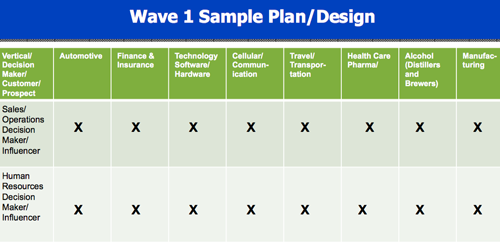Editor’s note: Michal Clements is co-author of Tuning into Mom and an independent management consultant, Los Angeles. This is an edited version of a post that originally appeared here under the title, “Driving innovation from B2B market research.”
 When conducting B2B market research for clients that sell to larger organizations (e.g., those with more than 1,000 employees), it’s typically a given that there are multiple decision-makers involved in choosing a vendor or service. For example, some combination of supply chain, purchasing, innovation/new product development, finance, marketing, operations, distribution and others can be important stakeholders.
When conducting B2B market research for clients that sell to larger organizations (e.g., those with more than 1,000 employees), it’s typically a given that there are multiple decision-makers involved in choosing a vendor or service. For example, some combination of supply chain, purchasing, innovation/new product development, finance, marketing, operations, distribution and others can be important stakeholders.
One of the first tasks is to figure out which individuals are most knowledgeable on most aspects of the decision, as it will typically be impractical to gather insights from all impacted parties. It can be extremely challenging to determine this, as many people within these large companies don’t really know who the proper person is for certain types of decisions.
A software platform firm
I recently came across the need for multiple perspectives on an assignment for a client who is designing a new software and business platform that will serve two different user groups:
- a generalized audience of all employees; and
- a specific audience of the sales-force.
We began with a B2B methodology and interview design that called for us to divide our qualitative interviews among “headquarters” decision-makers for these two audiences. For this case, decision-makers are typically found in sales or operations executive management and in human resources. Our sample design plan called for us to split the interviews among these job roles and across a range of industries.

Headquarters decision-makers
We ran into challenges with completing the headquarters decision-maker interviews because the type of platform we were exploring is only used by around 15-25 percent of organizations. Also, use of the platform is not readily verified either by employees within large corporations or by public domain information. Because of this, my colleague Gratia Wright and I spent a lot of time reaching decision-makers in companies, only to find they don’t use the right type of platform. Even when we asked an initial qualifying question in phone calls, e-mails and conversations, we still often needed to have a conversation explaining the topic to the interviewee to verify if they use the type of platform we were investigating.
When we found the correct person, the interview went well, and we explored questions surrounding:
- decision criteria;
- decision process;
- decision makers and timeline;
- software platform providers they know of and considered;
- how they learned about providers; and
- features desired.
While finding the decision-maker “needle in a corporate haystack” is not unusual in B2B research, this assignment proved more challenging than we typically experience. With the first wave of interviews completed, we moved forward with summarizing the two types of headquarters decision-makers (sales and HR) and shared the results of the first wave with the clients.
The end users
After reviewing the results of the first wave, our client made the decision to focus on the sales software platform and generated a new set of questions that were more appropriately answered by an end user, like a sales manager or sales person. For instance, how (desktop, tablet, phone), when (time of day, day of week) and where (office, on the road, home) are they accessing the platform? Which platform(s) do they currently use for sales incentives? Is the platform integrated with training or stand alone, etc.?
In general, this type of user-level data provided a helpful, complementary perspective to the headquarter decision-makers, and this input was most beneficial for innovation. With this change in focus, Wright and I switched gears from interviewing headquarters decision-makers to sales team leaders and sales executives across multiple industries.
This change opened many more potential interviewees, and had a much faster qualification process because users could immediately answer the question as to whether they were using the desired type of platform today. We were able to complete the wave two research more quickly and obtain the answers needed for the client to move forward.
In this research case study, as in many others for B2B, getting the perspective of multiple decision-makers was critical. We appreciated the flexibility of our client team to work through the design changes and achieve the answers needed.
Equally important was adapting the sample to reflect the different objectives as we sequenced our learning. If we were to do this study again, we would likely start sooner with the end-user perspective to accelerate our work and learning. Even if objectives focus exclusively on more “headquarters” decision-making, we would still suggest including end user perspective.
